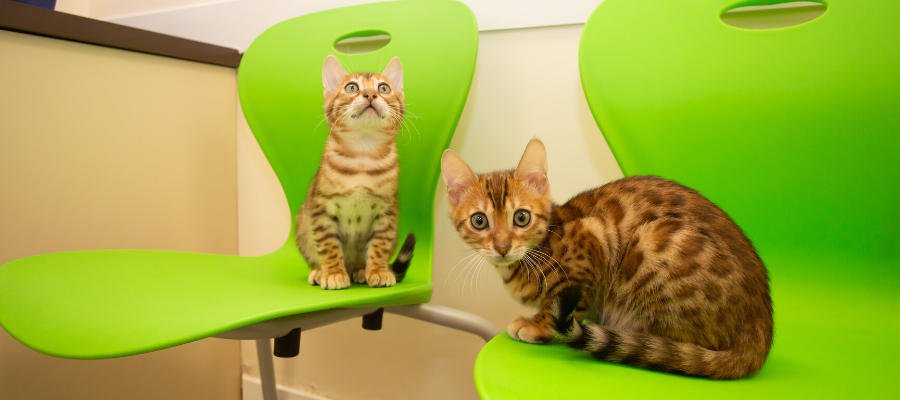What can I do to help look after my cat’s teeth?
A good diet is important for maintaining your cat’s dental health; there are special dental diets available with biscuits shaped to reduce plaque on the teeth. Stay away from dental sticks or treats which are not effective and generally too high in calories, instead opt for natural low-fat treats. The gold standard for dental care is to brush your cat’s teeth daily with a cat toothbrush and paste (available at the surgery)- please book in for a dental clinic with one of our nurses who can guide you through how best to clean your pet’s teeth and how to get them used to their toothbrush.
What is dental disease?
Dental disease is very common in cats – statistics show that 1 in 7 cats over the age of three years old are affected. It usually begins with a plaque deposit on the teeth (as with humans). This hardens to form tartar, which can be seen as a yellow-brown deposit on the tooth, beginning at the base of the tooth and gradually spreading to cover the entire tooth. As tartar forms it will spread beneath the gum line, allowing bacteria to encroach and cause an infection known as gingivitis.
If the infection travels deeper, into the area called the periodontal membrane (the ‘glue’ that holds the tooth in its socket) then the infection is termed periodontitis. Gingivitis is reversible, but periodontitis is not and usually requires the removal of the tooth.
What are the signs my cat might have a problem with their teeth?
The signs of dental disease include:
- Visible tartar
- Foul smelling breath
- Problems chewing (usually in later stages of dental disease, when it has already developed into a painful gingivitis)
- Gums that bleed easily
When cats struggle to chew, this leads to a vicious cycle where the affected teeth are not used so they are not being cleaned and further tartar builds up. In advanced stages, cats will find it difficult or impossible to eat and can often dribble constantly.
Cats rarely get rotten teeth (cavities) like we do. They may, however, suffer with a condition called FORLs (Feline Odontoclastic Resorptive Lesions) where the enamel of the tooth dissolves leaving an exposed painful nerve in the central cavity.
What impact does dental disease have on health?
As well as the obvious pain and discomfort associated with dental disease, your cat’s immune system constantly fights infection and over time your cat can become run down. Infections can track into the gums causing painful root abscesses. As your cat chews, some bacteria will be released into the blood stream and this can affect the kidneys, heart and liver. Recent surveys in older cats suggest that chronic dental disease can reduce your cat’s life span by up to 2 or 3 years as a result.
Some cats unfortunately have a form of gingivitis called ‘lymphocytic / plasmocytic gingivitis’, which is unrelated to tartar build up, caused by the body’s own inflammatory cells attacking itself. Removal of the tartar will help in these cases but unfortunately it will rarely cure the disease and your cat may need ongoing treatment (dental extractions, regular courses of antibiotics or regular corticosteroid injections) to control the problem.
What happens during a dental procedure at Heathfield Vets?
On admission, your cat will receive a full check over and a blood test if you wish- this is strongly recommended for all pets over 8 years old but is available for animals of any age. Your cat will be anaesthetised, and an ultrasonic descaler used to remove tartar from the teeth. We also probe all teeth to assess whether gum disease extends down into the periodontal membrane. If periodontitis is present, the tooth will need to be extracted. All teeth with FORLs also need extraction, as do any that are broken or loose.
Due to the size of their roots, canines, premolars and molars may need to be surgically extracted. An incision will be made over the gum, some of the bone drilled away and the tooth extracted ‘sideways’. Any stitches will dissolve without the need for later removal.
After your cat’s teeth have been descaled they will then be polished to leave a smooth surface, which will slow down the build up of plaque in the future. They will then be taken to recovery. They are monitored by a nurse throughout their procedure and recovery.
What care can I give after a dental procedure?
You will be asked to bring your cat back for rechecks, the number of which depends on how many extractions and what type they were. For a descale and polish, usually only one recheck is needed. This is usually done with a nurse, who will also discuss caring for the teeth and what can be done at home to prevent a further dental procedure from taking place.
For dental procedures that require extractions, there will usually be two rechecks, although this does vary depending on your pet’s needs. This will also include a discussion with the nurse regarding caring for teeth and what can be done at home. We’re here to guide you through the process and to help, so this is the perfect chance to ask any questions you have too!
What do I need to do to book in for a dental procedure?
The majority of dental procedures are recommended during consult, either because your cat has come in with a dental problem or because it has been picked up through the course of another consultation. You can then book in at reception, where one of our reception team will talk you through the process and arrange everything for you.
If we have not seen your cat before but you think they may need a dental procedure, just give us a call. We will book you a consultation with the vet who will assess the teeth and try to give an indication of what procedure will be needed. The grading given at this time is valid for three months – if the dental procedure is not carried out in that time, then we will need to see them again. The reason for this is that dental disease is progressive, and there can be big changes to their dental health in this time.
How much does a dental procedure cost?
Dental procedures are particularly difficult to estimate costs for as cats need to be under anaesthetic for a full assessment to be undertaken, particularly to establish whether or not they need extractions. The vet will assess the teeth in consult to give an estimate of costs and to check for any obvious dental damage. This is also the time for the vet to do a health check to make sure your cat is healthy and able to undergo the anaesthetic. On the day of the dental procedure, once they are anaesthetised, the vet will assess the mouth and depending on what is found, contact you if there will be additional costs above the estimate, as long as you are reachable by telephone.
- Costs for uncomplicated dental procedures include pre-medication, general anaesthetic, de-scaling and polishing.
- As many cats with dental disease fall into the ‘senior’ age range we would always advise a blood test before the anaesthetic to rule out any liver or kidney problems, especially as these can be seen more commonly when gum disease is present.
Does my cat have to have an anaesthetic to have a dental procedure carried out?
Anaesthesia is always recommended when carrying out any dental procedure. To descale the teeth (remove the tarter build up) not just so the teeth look better but so that the root cause of the problem is addressed, the procedure involves working near the gum line. T o do this while your pet is awake can be very distressing for them, and if they move or wriggle (which they are likely to do if awake) the instruments used can cause damage to the gums, introducing or worsening the infection and causing greater discomfort to your pet.
Call us on 01435 864422 to book an appointment today!


